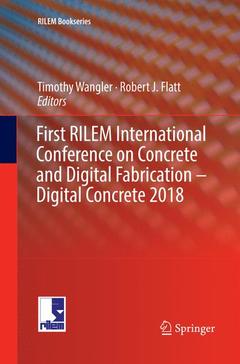First RILEM International Conference on Concrete and Digital Fabrication – Digital Concrete 2018, 1st ed. 2019 RILEM Bookseries Series, Vol. 19
Coordonnateurs : Wangler Timothy, Flatt Robert J.

Digital fabrication has been termed the ?third industrial revolution?, and is promising to revolutionize many disciplines, including most recently the construction sector. Both academia and industry see immense promise in cementitious materials, which lend themselves well to additive manufacturing techniques for digital fabrication in construction. With this recent trend and high interest in this new research field, the 1st RILEM International Conference on Concrete and Digital Fabrication (Digital Concrete 2018) was organized.
Since 2014, ETH Zurich has been host for the Swiss National Centre for Competence in Research (NCCR) for Digital Fabrication in Architecture, which is highly interdisciplinary and unique worldwide. In 2018, this NCCR opened the ?DFAB House?, which incorporates many digital fabrication principles for architecture. It is also responsible for the 600 m2 Robotic Fabrication Lab and the first robotically built roof in the world. Held in tandem with Rob|Arch 2018, the leading conference for robotics in architecture, RILEM deemed it the right time to combine forces at this new conference, which will be the first large conference to feature the work of the recently created RILEM Technical Committee on Digital Fabrication with Cement-based Materials, among other leaders in this new field worldwide.
This conference proceedings brings together papers that take into account the findings in this new area. Papers reflect the varying themes of the conference, including Materials, Processing, Structure, and Applications.
Theme 1: Materials and Processing.- Fresh and Hardened Properties of 3D Printable Geopolymer Cured in Ambient Temperature, by Shin Hau Bong, Behzad Nematollahi, Ali Nazari, Ming Xia, and Jay G. Sanjayan.- Evolution of Concrete/Formwork Interface in Slipforming Process, by T. Craipeau, T. Lecompte, F. Toussaint, and A. Perrot.- Experience in online modification of rheology and strength acquisition of 3D printable mortars, by V. Esnault, A. Labyad, M. Chantin, and F. Toussaint.- A Framework for Performance-based Testing of Fresh Mixtures for Construction-scale 3D Printing, by Ali Kazemian, Xiao Yuan, Ryan Meyer, and Berokh Khoshnevis.- Characterization of 3D Printing Mortars Made With OPC/CSA Mixes, by Noura Khalil, Sébastien Rémond, Bilal Baz, and Georges Aouad.- Rheological and water transport properties of cement pastes modified with diutan gum and attapulgite/palygorskite nanoclays for 3D concrete printing, by Siwei Ma, and Shiho Kawashima.- Rheological Control of 3D Printable Cement Paste and Mortars, by Scott Z. Jones, Dale P. Bentz, Nicos S. Martys, William L. George, and Austin Thomas.- Adapting Smart Dynamic Casting to Thin Folded Geometries, by Anna Szabó, Lex Reiter, Ena Lloret-Fritschi, Fabio Gramazio, Matthias Kohler, and Robert J. Flatt.- Enhancing Printable Concrete Thixotropy by High Shear Mixing, by Aileen Vandenberg, Hela Bessaies-Bey, Kay Wille, and Nicolas Roussel.- Discrete Element Simulations of Rheological Response of Cementitious Binders as Applied to 3D Printing, by Pu Yang, Sooraj Kumar A.O. Nair, and Narayanan Neithalath.- Theme 2: Mechanics and Structure.- Three-dimensional Printing Multifunctional Engineered Cementitious Composites (ECC) for Structural Elements, by Yi Bao, Mingfeng Xu, Daniel Soltan, Tian Xia, Albert Shih, Herek L. Clack, and Victor C. Li.- Large Scale Testing of Digitally Fabricated Concrete (DFC) Elements, by Freek Bos, Rob Wolfs, Zeeshan Ahmend, and Theo Salet.- Method of Enhancing Interlayer Bond Strength in 3D Concrete Printing, by Taylor Marchment, and Jay Sanjayan.- Exploiting the potential of digital fabrication for sustainable and economic concrete structures, by J. Mata-Falcón, P. Bischof, and W. Kaufmann.- Alternative Reinforcements for Digital Concrete Construction, by Viktor Mechtcherine, Venkatesh Naidu Nerella, Hiroki Ogura, Jasmin Grafe, Erik Spaniol, Martin Hertel, and Uwe Füssel.- Additive Manufacturing and Characterization of Architectured Cement-based Materials via X-ray Micro-Computed Tomography, by Mohamadreza Moini, Jan Olek, Bryan Magee, Pablo Zavattieri, and Jeffery Youngblood.- Hardened Properties of 3D Printable “One-Part” Geopolymer for Construction Applications, by Behzad Nematollahi, Ming Xia, Shin Hau Bong, and Jay Sanjayan.- Bond strength in 3D printed geopolymer mortar, by Biranchi Panda, Nishar Ahamed Noor Mohamed, Yi Wei Daniel Tay, and Ming Jen Tan.- Potentials of steel fibres for Mesh Mould elements, by P. Pfändler, T. Wangler, J. Mata-Falcón, R.J. Flatt, and W. Kaufmann.- Capillary water intake by 3D-printed concrete visualised and quantified by neutron radiography, by Christof Schröfl, Venkatesh Naidu Nerella, and Viktor Mechtcherine.- Corrosion Challenges and Opportunities in Digital Fabrication of Reinforced Concrete, by M. Stefanoni, U. Angst, and B. Elsener.- The effect of print parameters on the (micro)structure of 3D printed cementitious materials, by J. Van Der Putten, G. De Schutter, and K. Van Tittelboom.- Compressive Strength and Dimensional Accuracy of Portland Cement Mortar Made Using Powder-Based 3D Printing for Construction Applications, by Ming Xia, Behzad Nematollahi, and Jay Sanjayan.- Impact of 3D Printing Direction on Mechanical Performance of Strain-Hardening Cementitious Composites (SHCC), by Jing Yu and Christopher K.Y. Leung.- Theme 3: Applications and More.- Feasibility of using Low CO2 Concrete Alternatives in Extrusion-based 3D Concrete Printing, by Yu Chen, Fred Veer, Oguzhan Copuroglu, and Erik Schlangen.- Experimental Investigation on the Mechanical Strength and Thermal Conductivity of Extrudable Foamed Concrete and Preliminary Views on its Potential Application in 3D Printed Multilayer Insulating Panels, by Devid Falliano, Ernesto Gugliandolo, Dario De Domenico, and Giuseppe Ricciardi.- Development of a Shotcrete 3D-Printing (SC3DP) Technology for Additive Manufacturing of Reinforced Freeform Concrete Structures, by H. Lindemann, R. Gerbers, S. Ibrahim, F. Dietrich, E.Herrmann, K. Dröder, A. Raatz, and H. Kloft.- Challenges of real-scale production with Smart Dynamic Casting, by E. Lloret-Fritschi, F. Scott, F. Gramazio, M. Kohler, K. Graser, T. Wangler, L. Reiter, R.J. Flatt, and J. Mata-Falcón.- The Tectonics of Digitally Fabricated Concrete. A Case for Robotic Hot Wire Cutting, by Pedro Filipe Martins, Paulo Fonseca de Campos, Sandra Nunes, and José Pedro Sousa.- Compliance, Stress-Based and Multi-Physics Topology Optimization for 3D-Printed Concrete Structures, by Gieljan Vantyghem, Veerle Boel, Wouter De Corte, and Marijke Steeman.
Date de parution : 12-2018
Ouvrage de 334 p.
15.5x23.5 cm
Date de parution : 08-2018
Ouvrage de 334 p.
15.5x23.5 cm



